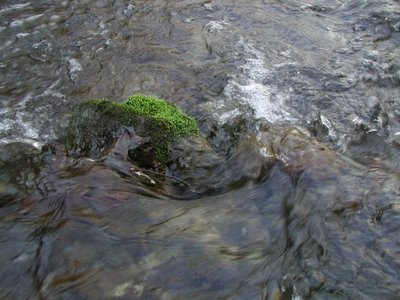Sunday, January 29, 2006
Lost in the Woods
 There is something deeply relaxing about losing one's self in the woods. I don't mean getting lost. Today is a very blustery day. There was a short shower around sunrise and I thought the weathermen were going to be correct: warm, then clouds and rain later. The sun broke through the clouds, however. It stayed warm and the rain held off. I decided that today would be great for a visit to the Clyde Buckley Wildlife Sanctuary, near Frankfort, but in the northwest corner of Woodford County (map).
There is something deeply relaxing about losing one's self in the woods. I don't mean getting lost. Today is a very blustery day. There was a short shower around sunrise and I thought the weathermen were going to be correct: warm, then clouds and rain later. The sun broke through the clouds, however. It stayed warm and the rain held off. I decided that today would be great for a visit to the Clyde Buckley Wildlife Sanctuary, near Frankfort, but in the northwest corner of Woodford County (map).The sanctuary is privately owned and operated by the Audubon Society. It is bounded on the west by the Kentucky River and the north by Glenn's Creek. The area is situated mostly on the uplands above the deep-cut valley of the Kentucky River. You can see the river from several overlooks (but only in the winter when the leaf cover is gone). It is a mixture of relatively mature woodlands and open fields. Many of the woodland areas have a well developed canopy and an open understory. Geologically, the upland is characterized by a rolling topography developed on karsted limestone terrains. The trails are easy with gentle up and down traverses. I like the Red Trail and prefer to take the short Yellow Trail loop to extend the hike to about 2.5 miles.
In the woods, I first notice the wind making a muted roar through the branches. The trees all sway slightly, so the woods snap, creak, and moan as branch rubs branch. I am very much reminded of what I think it might sound like to be on one of the many masted sailing ships of old. Against this background, sometimes leaves would dance and rattle as the wind blew across the forest floor. Robins rustle in the leaves foraging for worms and calling to one another as they dart upward into the trees. Now and again there would be a crack and snap as a dead branch gives way and plummets from the canopy. When I listen closely, I hear deer as they graze, nosing into the leaves, searching for tender green shoots and the seed pods of honey locust. I know that was the sound, because I watched two does at only about 25 yards distance.
You develop a rhythm as you walk. I inhale for four strides and then exhale for four. They are controlled and deep, full breaths. I can smell the woods: leaves, moss, moist rotting wood. It all combines to make that "outdoors" smell, and Beverly will say that when I return. All-in-all, it is a satisfying meditation.
Bye the way, you might try to guess what is going on with the hole in the tree in the picture. The hole is about 10 inches long and 3 to 4 inches deep. There are also several smaller holes. You can't examine the details of the hole as I did, but you might come to the same conclusion as I did anyway. The holes can only be the work of a woodpecker. The only woodpecker I'm familiar with that will land on the ground or very low on trees and is big enough to make such a hole is the Pileated Woodpecker.
Monday, January 16, 2006
Cove Spring in Winter
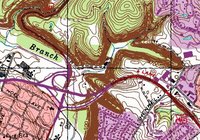
One of my favorite places to go and have a nice walk is Cove Spring Nature Preserve, Frankfort's newest park. The preserve is located off Highway 127 (Owenton Road), north of the interchange of 127 with Wilkinson Boulevard. The spring is the source of the stream commonly known as penitentiary Branch after it enters the wetland west of 127 and behind the State Highway garage. Early pioneers in the Frankfort area used the spring as a water supply. A dam was built to increase the reliability of the water supply. The small lake became Frankfort's first public water supply. The dam leaked and the impoundment was abandoned sometime before the 1880's when a pumping station, water storage, and filtration plant were built to better serve the growing population. The dam itself was breached for safety (to keep it from catastrophically failing), and the area pretty much forgotten. The property was owned for many years by a family who preserved the site and eventually made it available to the City of Frankfort. With the assistance of several Eagle Scout projects, trails have been developed. The facility includes picnic shelters, benches along the trails and a trout race.
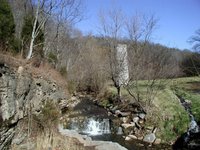 On entering the park, past the shelters next to Hurst Falls you get a view of the meadow that was the former lake bed. The stone tower is an overflow structure that kept the water level from topping the dam. The base of the dam was about where the little unnamed falls in the picture is located. Out of the frame to the right, the south half of the dam still stands. The falls is developed on the Ordovician Tyrone limestone which also crops out along the left margin of the photo. This is a dense mudstone that was deposited in a broad open tidal flat similar to Andros Island in the Bahamas today. You can see millimeter thin layers formed as the tides swept in and out, mud cracks, and other features are visible on close inspection. The Tyrone was once commonly quarried as a building stone. Many buildings that are faced in "Kentucky Marble" are Tyrone limestone. In the lower left you will notice some thinner beds that continue along the outcrop. The layers forming the falls are just below these thinner rock units. These rocks were deposited in the tidal flat, but are actually a bentonite bed, a volcanic ashfall preserved for hundreds of millions of years. During the Ordovician, the beginnings of the Appalachian Mountains were a volcanic island arc, similar to Indonesia today. The ash from several eruptions has been preserved in these limestone rocks. The volcanic glass and minerals making up the ash has weathered over time to become the clay mineral called bentonite.
On entering the park, past the shelters next to Hurst Falls you get a view of the meadow that was the former lake bed. The stone tower is an overflow structure that kept the water level from topping the dam. The base of the dam was about where the little unnamed falls in the picture is located. Out of the frame to the right, the south half of the dam still stands. The falls is developed on the Ordovician Tyrone limestone which also crops out along the left margin of the photo. This is a dense mudstone that was deposited in a broad open tidal flat similar to Andros Island in the Bahamas today. You can see millimeter thin layers formed as the tides swept in and out, mud cracks, and other features are visible on close inspection. The Tyrone was once commonly quarried as a building stone. Many buildings that are faced in "Kentucky Marble" are Tyrone limestone. In the lower left you will notice some thinner beds that continue along the outcrop. The layers forming the falls are just below these thinner rock units. These rocks were deposited in the tidal flat, but are actually a bentonite bed, a volcanic ashfall preserved for hundreds of millions of years. During the Ordovician, the beginnings of the Appalachian Mountains were a volcanic island arc, similar to Indonesia today. The ash from several eruptions has been preserved in these limestone rocks. The volcanic glass and minerals making up the ash has weathered over time to become the clay mineral called bentonite.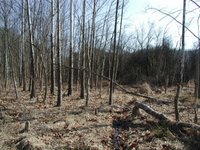 An important part of the Cove Springs Nature Preserve (and it's newest development) is the ephemeral wetland area of the park. This area is located across Highway 127 and is along Penitentiary Branch, behind the State Highway Garage. Up until a few years ago, this area was the undisturbed home of beaver and muskrat (almost in downtown Frankfort believe it or not). A complaint about mosquitoes from the residents of the Holmes Street area and the fact that the beaver dam was not in compliance with the Corps of Engineers flood control plans led to the elimination of the beavers. As you walk along a built-up trail to an observation shelter, you can still see the handiwork of the industrious creatures.
An important part of the Cove Springs Nature Preserve (and it's newest development) is the ephemeral wetland area of the park. This area is located across Highway 127 and is along Penitentiary Branch, behind the State Highway Garage. Up until a few years ago, this area was the undisturbed home of beaver and muskrat (almost in downtown Frankfort believe it or not). A complaint about mosquitoes from the residents of the Holmes Street area and the fact that the beaver dam was not in compliance with the Corps of Engineers flood control plans led to the elimination of the beavers. As you walk along a built-up trail to an observation shelter, you can still see the handiwork of the industrious creatures.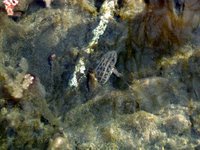 Of course, what can be seen at the preserve is not all geology. If you know where to look, and look carefully, you can see all kinds of animals. On the trail to the spring, I observed a Piliated Woodpecker for about 20 minutes. This bird of impressive size and brilliant color flew from tree to stump to ground. Often, it lingered on the ground next to a fallen log, chipping at the rotten wood. I didn't have a long enough telephoto lens to get a picture. It finally flew off when two women with a yippie dog approached. They never even noticed it as they approached too close and induced the startled the bird deeper into the woods and higher into the trees. I followed it with binoculars as it climbed a dead, standing sycamore. It stopped about a meter below a red-bellied woodpecker on the opposite side of the same tree. A bit more down to earth, perhaps, frogs are active, even in January around some of the spring-fed pools. This one was nestled in the algae in about 12 centimeters of water. Sometimes, they'll be sunning around the edge of the pool, but not today.
Of course, what can be seen at the preserve is not all geology. If you know where to look, and look carefully, you can see all kinds of animals. On the trail to the spring, I observed a Piliated Woodpecker for about 20 minutes. This bird of impressive size and brilliant color flew from tree to stump to ground. Often, it lingered on the ground next to a fallen log, chipping at the rotten wood. I didn't have a long enough telephoto lens to get a picture. It finally flew off when two women with a yippie dog approached. They never even noticed it as they approached too close and induced the startled the bird deeper into the woods and higher into the trees. I followed it with binoculars as it climbed a dead, standing sycamore. It stopped about a meter below a red-bellied woodpecker on the opposite side of the same tree. A bit more down to earth, perhaps, frogs are active, even in January around some of the spring-fed pools. This one was nestled in the algae in about 12 centimeters of water. Sometimes, they'll be sunning around the edge of the pool, but not today.Cove Spring is a very quiet and contemplative spot. State workers park in the lot on their lunch breaks. In many places, the stream tumbles over rocks and falls and with the birds they drown out the monotone whoosh of distant passing cars. Moist leaves on the trails make for silent walking. The startlingly green moss on rocks and fallen timbers stands out in contrast to the browns of the rest of the winter foliage.
